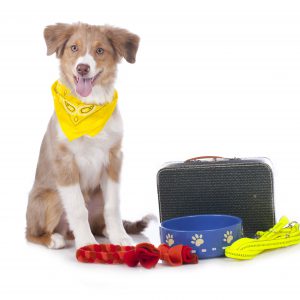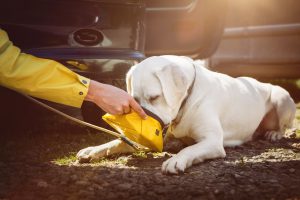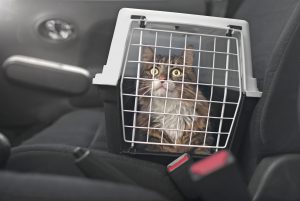10 Safety Tips for Traveling With Your Pet
Traveling solo can be hard enough as it is — from making sure your bag is totally packed to ensuring that everything’s all locked up before you leave the house, the long and stressful process of getting up and going somewhere can really take a lot out of you. Throw kids, friends, family members, or a mix of the three into the equation, and things are only going to get more complicated.
Thankfully, traveling doesn’t have to get even more stressful than it already is just because you’re bringing your pet along. These ten safety tips are sure to make traveling with your pet easier, not harder. From crate tips to feeding times and everything in between, you can depend on these pointers to guarantee a smooth, stress-free trip for you and your furry best friend.

Use a Carrier or Crate
No matter if you’re traveling by plane, train, or automobile, a carrier or a crate for your dog or cat is absolutely the way to go. Unless your dog is small enough to fit on your lap, traveling by air or rail means your pet will need to remain in their crate for the duration of the flight. With that being said, you should never have your cat or dog out of their carrier when traveling by car. It’s never safe.
Make Sure Their ID Tags are Up to Date
Before you leave, you’ll want to check your pet’s ID tag to make sure that the contact info on it reflects the most current information. Look over any home addresses, phone numbers, or email addresses that you might have printed on the reverse side opposite their name and, if anything has changed, go ahead and get a new tag made. If your state requires a rabies tag for dogs (and, odds are, they do), make sure that’s up to date too.
Prepare Them for the Road Ahead
If you’re going to be traveling by car, you can prepare your dog or cat for their upcoming trip by putting them in their travel crate and taking them for increasingly long drives in the weeks and months leading up to the big day. This will get them accustomed to the car ride and also let you know how they do in the car so that you know what to expect (and, as a result, what to prepare for).

Bring a Travel Kit
Are you bringing a backpack stocked with good snacks, important papers, and fun things to do on the ride to your destination? You should do the same for your pet! Grab a folder or an envelope and put all their most recent records in it, then stick it in a bag with toys, food, water bottles, extra leashes, and any medications they may take. Having this travel kit handy will make a world of difference and save you the trouble of searching through suitcases when making a pit stop.
Research Vets Before Leaving
You never know when a medical emergency might come up, so it’s best to know the name, hours, and location of the area’s veterinarians and animal hospitals before you leave. Even something as simple as an upset stomach could put your pet in need of medical attention while away from home, so it’s good to know exactly where to go on the off chance you need to take them to see the vet. National Motor Club’s trip planning tool makes this easier than ever, giving you the means and the convenience of providing you with the research on your destination before you even leave the house. Check it out for yourself!
Make Frequent Stops
 When traveling by car, it’s in your best interest to stop frequently and let your pet stretch their legs for a bit. Let them use the restroom, sniff around, and decompress for a little before heading back out on the road again. It’ll make the car ride easier for both you and them if they’re not cooped up the entire time from point A to point B. Plus, a chance to burn off some energy might mean they nap for the rest of the way there!
When traveling by car, it’s in your best interest to stop frequently and let your pet stretch their legs for a bit. Let them use the restroom, sniff around, and decompress for a little before heading back out on the road again. It’ll make the car ride easier for both you and them if they’re not cooped up the entire time from point A to point B. Plus, a chance to burn off some energy might mean they nap for the rest of the way there!
Plan Feedings Carefully (and Water, Too)
You probably don’t need to be reminded that pets can get carsick, too. If your trip coincides with feeding time, try giving them their breakfast or dinner a few hours before you depart — this will give their food a chance to settle before you head out on the road. As for water breaks, feel free to give them a drink whenever you stop and stretch (as long as you can plan for a potty break later on down the road).
Watch the Temperature
Whether they’re riding on a train, in a car, or on a plane, it’s vital that your pet stay nice and comfortable. Temperature is a big part of this. If traveling by car, make sure they get some air conditioning or some heat, depending on the outside temp. If traveling by train or plane, see if the area where their crate will be stored is climate controlled. If not, make sure they’re moved to an area that is. A breathable, USDA-approved crate is also a must-have.

Additional Car Safety
Some additional car safety tips include waterproof seat covers and floor mats in case of any accidents and placing a friend or family member or loved one that knows the pet in the back with them so that they’re not too disoriented. These extra steps will help you go the extra mile in ensuring your pet’s complete and total safety while traveling.
Additional Plane Safety
If you’re going to be traveling by plane, you should consider consulting with your vet first to make sure that your pet is healthy enough to travel by air (which, in most cases, requires them to be sedated). Also, be sure to book direct flights and guarantee that your pet is flying on the same flight as you. These plane tips will help maximize the safety of your four-legged friend so everyone arrives at the destination safely and soundly.



44 Comments. Leave new
pfizer viagra description
can i buy cialis over the counter in canada
cual es el nombre generico de viagra Abigo tiz
cialis (generic) viagra cialis melbourne site:au generic cialis [url=http://21cialismen.com/]buy brand cialis online[/url] ’
buying cialis without a prescription cialis prices cialis [url=http://cialijomen.com/]cialis buy online canada[/url] ’
denton viagra fast shipping viagra cheap viagra for 30 years old [url=http://genericrxxx.com/].buy viagra[/url] ’
buy cheap viagra cialis & viagra buy generic viagra mastercard [url=http://genqpviag.com/]ordering viagra online is it legal[/url] ’
buy viagra without prescription viagra next day delivery usa buy viagra no prescription [url=http://genqpviag.com/]cheap viagra[/url] ’
viagra for sale no prescription viagra25mg viagra us overnight mastercard accepted [url=http://llviabest.com/]viagra online 500mg[/url] ’
cialis 80 mg buy cialis no prescription uk cialis black buy in australia [url=http://cialmenshoprx.com/]cheap cialis pills[/url] ’
cialis cheap medications cialis australia [url=https://xz-pharmacyonline.com]Mestinon[/url] ’
cialis (generic) buy cialis without doctor prescription cialis and pay pal [url=http://loncialis.com/]cialis 10mg[/url] ’
viagra mexico pharmacy discussion on viagra does alcohol inhibit viagra [url=https://canadianpharmacy-usx.com/organic.htm]coupon viagra prescription[/url] ’
where to buy viagra in toronto quickly ordering viagra through paypal viagra online paypal uk [url=http://llviabest.com/]buy viagra australia[/url] ’
viagra ad on xm radio sample viagra for free u. s. overnight viagra [url=http://genqpviag.com/]which is better viagra cialis or levitra[/url] ’
bootleg viagra viagra dapoxetine online cheap viagra online pharmacy [url=http://xz-pharmacyonline.com/en/career-opportunities.html]viagra in toronto[/url] ’
cialis professional legitimate cialis for sale in canada cialis 36 hours [url=http://sjcialis.com/]buy shop cialis 20mg[/url] ’
viagra super force chdap viagra viagraforsale [url=http://genqpviag.com/]viagra cheap 100mg[/url] ’
cialis without a prescription Elavil cialis dosage [url=https://impotencecdny.com/]Eldepryl[/url] ’
free viagra sample canada best online canadian pharmacy generic viagra priligy australia [url=http://erectilejyzd.com/]Prilosec[/url] ’
generic viagra with dapoxetine 80mg buy viagra 10 tab is there a legal generic viagra made in the united states [url=http://erectilejyzd.com/index.php?called=terms]viagra and no prescription[/url] ’
ebay viagra pills where to buy viagra with no prescription can buy viagra over counter australia [url=http://llviabest.com/]price of viagra at walmart[/url] ’
Aurogra online pharmacies no prescription best canadian online pharmacies [url=https://canadianpharmacy-yy.com/]Fertomid[/url] ’
best viagra sale sites
buy viagra boots
is it illegal to buy viagra off craigslist Abigo tiz
cheap genuine viagra online buy viagra prescription buy brand viagra canada [url=http://canadianpharmacy-yy.com/Fitness/how-to-get-a-six-pack.html]viagra soft sale[/url] ’
over the counter viagra for sale viagra sale in uk viagra overnight delivery usa [url=http://llviabest.com/]viagra and dapoxetine160 mg[/url] ’
cialis 200 mg. fast delivery cialis super active brand cialis online pharmacy [url=https://impotencecdny.com/info/history.php]cialis sale[/url] ’
viagra viagra minn overnight delivery for viagra [url=http://genqpviag.com/]viagra mail order[/url] ’
how to talk to a doctor about viagra pfizer viagra viagra with dapoxetine overnight delivery [url=http://llviabest.com/]viagra in dubai[/url] ’
buy viagra in atlanta in a store denton viagra ordering viagra onl [url=http://genqpviag.com/]generic viagra with dapoxetine 160mg x 16 tabs[/url] ’
paxil cheap
when will generic cialis be available
brand levitra from canada Abigo tiz
howard stern commercial cialis cialis generic overnite cialis uk
free viagra samples canada getting viagra in cape town best viagra online sites
ordering viagra gold online viagra cost walmart questions about viagra
pharmacies online discount pharmacies online pharmacy without a prescription
safe to order viagra what ingredients inside viagra viagra buy
viagra by canadian pharmacy
cvs viagra
generic cialis 2.5 mg online Abigo tiz
viagra generic canadian pharmacy sign up viagra dapoxetine
[url=http://www.cialiseven.com/]back pain from cialis[/url] whats better cialis levitra or viagra
the canadian pharmacy canada drug prices online pharmacy
[url=https://dociali.com/]buy cialis mexico[/url] generic cialis bijwerkingen
vardenafil ed meds online canadian cialis
no prescription online pharmacy cheap canadian drugs drug prices comparison
online pharmacy no prescription needed no prescription pharmacy viagra generic online pharmacy
[url=https://dociali.com/]cialis youtube[/url] cialis epididymitis
arava on backorder
does generic viagra work
25 mg viagra did not work Abigo tiz